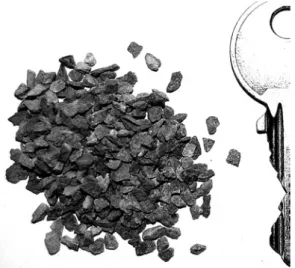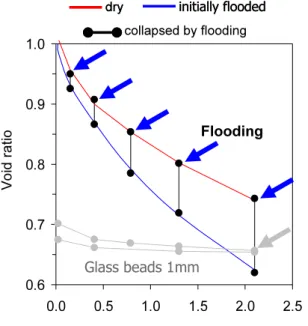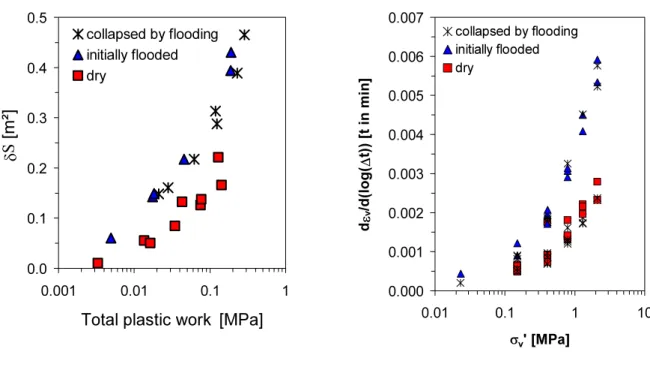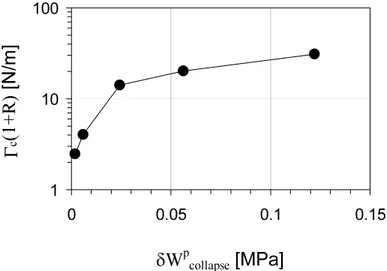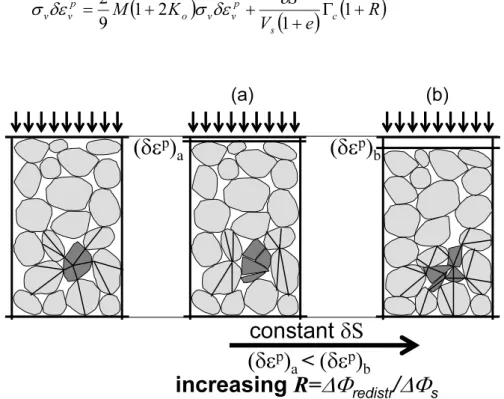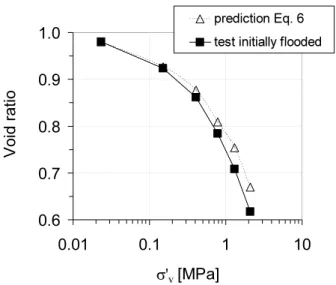HAL Id: hal-01008603
https://hal.archives-ouvertes.fr/hal-01008603
Submitted on 30 May 2017HAL is a multi-disciplinary open access archive for the deposit and dissemination of sci-entific research documents, whether they are pub-lished or not. The documents may come from teaching and research institutions in France or abroad, or from public or private research centers.
L’archive ouverte pluridisciplinaire HAL, est destinée au dépôt et à la diffusion de documents scientifiques de niveau recherche, publiés ou non, émanant des établissements d’enseignement et de recherche français ou étrangers, des laboratoires publics ou privés.
On the plastic work of crushable soils under compression
Carlos Ovalle, Christophe Dano, Pierre-Yves Hicher
To cite this version:
Carlos Ovalle, Christophe Dano, Pierre-Yves Hicher. On the plastic work of crushable soils under compression. The 2012 World Congress on Advances in Civil, Environmental, and Materials Research (ACEM’ 12), Aug 2012, Séoul, South Korea. pp.612-619. �hal-01008603�
On the plastic work of crushable soils under compression
Carlos Ovalle
1), Christophe Dano
2)and Pierre-Yves Hicher
3)1), 2), 3) GeM, Ecole Centrale Nantes, CNRS UMR 6183, Nantes, France 1)* Department of Structural and Geotechnical Engineering, Pontificia Universidad
Católica de Chile, Chile 1)
carlos.ovalle@@ec-nantes.fr ; 2) christophe.dano@ec-nantes.fr
ABSTRACT
The plastic work done by crushable soils under quasi-static compression can be partitioned between friction sliding and the energy dissipated by grain crushing. For the second term, Griffith’s theory can be used in order to account for creation of new surface on crushed particles. Moreover, after the breakage of a grain the inter-particle forces chains on him could vanish, producing a redistribution, or collapse, of its neighbors particles. This effect could represent a non negligible amount of plastic work. However, very few works has been reported in this issue and there is no clear experimental evidence of the partition of the plastic work: friction – surface increment – redistribution after crushing. In this paper, we explore this issue by performing oedometric tests in crushable sand specimens. We show that at relatively high stresses the increment of the Griffith’s surface increment represents less than 10% of the total dissipation and the rest should be captured by the redistribution of the material skeleton. Our results are in accordance with some theoretical values from the literature.
1. INTRODUCTION
Usually, the plastic work done by granular soils under quasi-static compression has been associated in constitutive models by the term of the Cam-Clay model:
∆Φfriction=Mp’δεsp ; where p’ is the mean effective stress, M is the mobilized friction at the
critical state and δεsp is the deviatoric plastic strain increment (Roscoe et al., 1963).
However, when grain crushing occurs, it is necessary to add a new term of dissipation in order to consider the increasing of the plastic volumetric contraction when the grain size distribution (gsd) changes. In order to take into account this phenomenon, some models based on the Cam-Clay model have been proposed by introducing an equation which pushes down the critical state when crushing develops (Daouadji et al., 2001; Russell & Khalil, 2004; Muir Wood et al., 2009; Daouadji & Hicher, 2010; Hu et al.,
1)
2011). These kinds of phenomenological models can capture indirectly the mechanical response of crushable material but they are not able to predict the evolution of the gsd or the increment of grains surface area due to breakage, which are both linked to the plastic work (Miura & O-Hara, 1979; Hu et al., 2011). On the other hand, a physical based model should consider that the increment of the plastic work (δWp) in confined comminution is due, not only to sliding friction between grains, but also to dissipation by breakage (∆ΦB): B friction p W =∆Φ +∆Φ δ (1)
An interesting approach to evaluate ∆ΦB was proposed in the pioneering work of McDowell et al. (1996), by using the Griffith’s theory (Griffith, 1921). They considered that ∆ΦB could be expressed as the creation of new surface area on crushed grains (δS) in a volume of solid grains (Vs), by means of the specific surface energy of the Griffith’s
theory (Γ). According to Griffith (1921), this means that the elastic strain energy stored on compressed grains is released as a surface increment on fractured solids:
(
e)
V S s s B =∆Φ = Γ + ∆Φ 1 δ (2)where e is the void ratio and Γ is the specific surface energy, which is a material constant representing the energy required to propagate a crack in a unit of surface, in a given mode of fracture. Based on Eqs. 1 to 3, McDowell & Bolton (1998) developed an equation in order to predict a linear compression line on the e-logp’ space. They assumed that the gsd tends to a fractal distribution at high stresses. However, they did not give any experimental validation of their equation. Using a thermomechanical approach, Einav (2007) proposed a critical pressure formula for the onset of “significant” grain crushing, analogous to the critical stress of Griffith (1921). Einav’s equation includes a critical breakage energy which is needed to start crushing, equivalent to the specific fracture energy Γ. Similarly, Pugno & Carpinteri (2008) applied the Griffith’s energy balance to predict the isotropic pressure needed to get a given increment of surface. The authors stated that the specific energy in confined comminution accounts for fracture and friction. This is a fundamental difference between classical fracture mechanics and confined comminution, i.e., the dissipation by unit of new surface must include, not only the Griffth’s energy on the brittle grain, but also the rearrangement of the particles surrounding a crushed grain. This rearrangement leads to a non-negligible plastic strain due to grain slip and inter-particle friction triggered by the fact that force chains on the crushed grain could vanish. Likewise, it has been proposed that the total breakage dissipation ∆ΦΒ is not given only by ∆Φs (from Eq. 2), but includes also the mentioned redistribution of neighbors grains (Nguyen & Einav, 2009; Russell, 2011; Nieto-Gamboa, 2011); this is: ∆ΦΒ =∆Φs+∆Φredist.
For example, Russell (2011) proposed that ∆Φredist could be taken as proportional to
∆Φs, through the ratio R=∆Φs/∆Φredist; namely: ∆ΦΒ =∆Φs(1+R). Motivated by the work of
account for the total breakage dissipation (if R=0, it remains the equation of McDowell et al., 1996):
(
e)(
R)
V S Mp q p s p q p q p v + = ' + Γ1+ 1+ 'δε δε δε δ (3)Finally, assuming a fractal distribution for the gsd and also for the pore size distribution once an important amount of crushing occurs (i.e. at high stresses), Russell (2011) showed that a fitting of R around 13 to 15 is necessary to represent an oedometric compression line for two silica sands tested by Nakata et al. (2001). It has also been proposed that R depends on the stress path (Russell, 2011; Nguyen & Einav, 2009) but, as far as we know, there is no experimental evidence on this issue.
Fig. 1. Quartzite shale sand 2-2.5mm from Trois Vallées quarry 2. OEDOMETRIC TESTS ON CRUSHABLE SAND
In this paper, we present an experimental method in order to measure the role of the increment of fracture surface energy on the total plastic work of a brittle granular material. We run several oedometric compression tests on crushable sand with uniform initial gsd of 2 to 2.5 mm and angular grains (see Fig. 1). The material was obtained from the grinding of a quartzite shale rock from Trois Vallées quarry, in the north of France. The density of solids is 27 kN/m3. To avoid crushing during preparation, loose samples of dry material were prepared by pluviation with a null fall height and soft tamping at an initial void ratio of 1.00 +/- 0.02 in a cylindrical mould of 19 mm high and 70 mm of diameter. Several oedometric tests were performed with stress control at different effective vertical stress levels: σv’= 0.15, 0.4, 0.8, 1.3 and 2.1 MPa. Load was
kept during 24 hours at each level. For each stress level, we loaded and unloaded for three conditions: (1) dry material, (2) initially flooded material and (3) a dry sample collapsed by flooding at the maximal effective vertical stress. We used demineralized water and we did not observe any chemical reaction or dilution after wetting the material. After each test, samples were accurately sieved between 2.5mm and 0.08mm.
Fig. 2 presents a summary of the compression curves for dry and flooded tests (the arrow stands for the instant of flooding at different stress levels). We also compressed a dry sample of uniformly sized glass beads of 1 mm of diameter. We did not get any crushing of glass beads at σv’=2.1 MPa and after flooding we did not observe collapse (see Fig. 2). In order to get a cleaner figure, in Fig. 2 we show only the measurements before and after collapse for the flooded tests. As reported in the literature (Marsal, 1973; Lee et Coop, 1995; Oldecop & Alonso, 2001), we observed that the material is more compressible when it is flooded, regardless of the point of flooding (i.e. initially flooded or at the maximal σv’). Oldecop & Alonso (2001) explained this phenomenon by means of the subcritical crack propagation theory, stating that if the water content increases (or suction decreases), the fracture toughness factor is affected and crack propagation velocity can be drastically increased. This is the case when flooding dry samples at constant stress, where grain breakage triggers a collapse.
0.6 0.7 0.8 0.9 1.0 0.0 0.5 1.0 1.5 2.0 2.5 σv' (MPa) V oi d r ati o Flooding Glass beads 1mm
dry initially flooded collapsed by flooding 0.6 0.7 0.8 0.9 1.0 0.0 0.5 1.0 1.5 2.0 2.5 σv' (MPa) V oi d r ati o Flooding Glass beads 1mm
dry initially flooded collapsed by flooding
Fig. 2. Oedometric tests on quartzite shale crushable sand
Let us consider that the volume v of each grain is a function of its characteristic diameter d: v(d)=βvd3 (where βv is the particle shape factor). Then, the surface area on a grain is given by s(d)=3βvd2 and for a given size fraction of characteristic diameter di is given by S(di)=Nis(di)=3Niβvdi2 (where Ni is the number of particles in the size fraction). One can also write the mass of the size fraction as mi(di)=Niρv(di)=Niρβvdi3 and the retained gsd is given by fi(di)=mi(di)/Mt (where ρ is the mass density of solids and Mt is the total mass of the sample). Assuming that βv is the same for every size fraction and combining S(di) and fi(di), we can get the increment of surface area after crushing from the change of the gsd ∆fi(di) (Nieto-Gamboa, 2011):
( )
( )
i i t i d d f M d S ρ δ = 3 ∆ (4)For the finer fractions d<0.08mm and 0.08mm<d<0.16mm we measured the surface area by the Blaine test (air permeability) and we have got values of 0.270 m²/gr and 0.105 m²/gr, respectively. Fig. 3 shows the increment of surface area (from Eq. 4 and Blaine tests for d<0.16mm) on samples after each compression test as a function of the total plastic work. The plastic work after each loading level was computed as δWp=σ
v’δεp, by subtracting the elastic strain recovered after unloading. The total plastic
work is the sum of each δWp for each stress level in a test. It can be seen that dry samples follow a unique curve of surface increment, separately from flooded samples which exhibit more crushing. We also compare the settlement curves during 24 hours of dry and flooded samples. Fig. 4 shows the slope of the creep curves between 1 min and 24 hours (dε/log(∆t)). Regardless of the flooding point, flooded samples present the same slope on Fig. 4, which is steeper than dry samples. This result is consistent with the unique compression curve of flooded samples (Fig. 2) and the unique surface increment after flooding (Fig. 3).
0.0 0.1 0.2 0.3 0.4 0.5 0.001 0.01 0.1 1
Total plastic work [MPa]
δS [m² ] collapsed by flooding initially flooded dry 0.000 0.001 0.002 0.003 0.004 0.005 0.006 0.007 0.01 0.1 1 10 σv' [MPa] dε v /d (l o g (∆ t) ) [ t i n m in ] collapsed by flooding initially flooded dry 0.000 0.001 0.002 0.003 0.004 0.005 0.006 0.007 0.01 0.1 1 10 σv' [MPa] dε v /d (l o g (∆ t) ) [ t i n m in ] collapsed by flooding initially flooded dry
Fig. 3. Increment of surface area on grains after an oedometric test
Fig. 4. Slope of creep tests during 24 hours
3. COMPUTATION OF THE PLASTIC WORK BY THE GRIFFITH’S THEORY
As explained by Oldecop & Alonso (2001), we assumed that the collapse of flooded samples is triggered by grain crushing. This is also supported by the compression test on glass beads, without crushing or plastic strain after flooding (see Fig. 2). Therefore, at a given constant effective vertical stress, the plastic work done after flooding (after a given time of creep, here during 24 hours), is partitioned only between ∆Φs and ∆Φredist
done during 24 hours of creep of the compressed dry sample at each loading level. On the other hand, measuring the difference between δS after a dry sample test and after a flooded one at the same vertical stress, we can compute the increment of surface area due to collapse δScollapse. Thereafter, in order to fit the measured plastic work by creep after flooding at constant effective vertical stress (δWp
collapse), we used the expression of
Russell (2011):
(
e) (
R)
V S W c s collapse p collapse v p collapse = ' = 1+ Γ 1+ δ δε σ δ (5)where δεpcollapse is the plastic strain increment measured during collapse after flooding at constant σv’. In Eq. 5 we deliberately used Γc, for comminution, which is not necessary the same as the Griffith’s constant Γ. In fact, grain splitting in confined comminution will occur under a random inter-particle contact forces, which could lead to a random mode of fracture (traction or shear). For instance, a grain belonging to a strong chain force could be fractured by induced bulk traction, analogous to a Brazilian test. On the other hand, friction on grain contacts could produce fines by shear induced stresses. Moreover, the surface energy on confined comminution could be captured by the parameter Γc(1+R), including the dissipation by fracture (new Griffith’s surface area) and the redistribution triggered by breakage.
1 10 100 0 0.05 0.1 0.15 δWpcollapse [MPa] Γ c (1+R ) [N /m]
Fig. 5. Specific fracture energy obtained after oedometric test collapsed by flooding
Fig. 5 shows the parameter Γc(1+R) for each test collapsed by flooding. It is clear that its value increases with the stress level. Let us assume that Γc is a material constant and the minimal plastic work that can be done in confined comminution corresponds to the increment of surface area on crushed grains. Following this argumentation, we suggest that the surface fracture energy Γc could be obtained from
Fig. 5, when the plastic work tends to zero, which gives approximately 2.5 N/m on our tests. This value is similar from some reported parameters of surface fracture energy of
shale rocks of around Γ=5 N/m for fracture in mode I (Ashby & Jones, 2006). Therefore, the evolution of Γc(1+R) in Fig. 5 is due to the increment of R with the stress level and the dissipation by redistribution after crushing depends on the stress magnitude. Conceptually, it could be expected that when a grain splits under low macro-mechanical stress, its neighbors could be able to support the redistributed local stresses and rearrange the contact force network with negligible plastic work other than the increment or surface area (see Fig. 6a). On the other hand, for a relatively high macro-mechanical stress, it could happen a local collapse of the material skeleton and the dissipation by redistribution could be several times the energy dissipation by surface increment (see Fig. 6b). Quantitatively, for Γc=2.5 N/m, at σv’=0.15 MPa the term ∆Φs represents almost 100% of the total dissipation and it drops to less than 10% in the test at σv’=2.1 MPa.
Using the R values obtained from collapse tests (Fig. 5 with Γc=2.7 N/m), we reproduced the oedometric compression curve of the initially flooded samples. We used Eq. 3 adapted for an oedometric stress path (Russell, 2011), with typical values for angular sands of M=1.4 and Ko=1-sinφ=0.43.
(
)
( ) (
R)
e V S K M c s p v v o p v vδε = 92 1+2 σ δε + δ1+ Γ 1+ σ (6)constant δS
increasing R=∆Φ
redistr/∆Φ
s(δε
p)
a(δε
p)
b (a) (b)(δε
p)
a< (δε
p)
bFig. 6. Schematic partition of the plastic work
Fig. 7 presents the prediction of the compression curve according to the Russell’s equation using our computations of R. We obtain a very good agreement with the experimental results.
0.6 0.7 0.8 0.9 1.0 0.01 0.1 1 10 σ'v [MPa] V o id r atio prediction Eq. 6 test initially flooded
Fig. 7. Prediction of the oedometric compression curve on crushable shale sand CONCLUSION
We used the phenomenon of collapse triggered by crushing after flooding on sand in order to study the partition of the plastic work in confined comminution. We identified the energy dissipation by increment of surface area according to Griffith’s theory and we obtain the dissipation by redistribution of the material skeleton after crushing, according to Russell’s equation (Russell, 2011). The redistribution term captures the rearrangement of the material skeleton (inter-particle friction and grain sliding) due to local changes in the inter-particle contact forces after breakage, as a function of the increment of surface area on crushed grains. We assumed that the specific surface energy is a material constant and that the creation of new surface is the minimum possible energy dissipation due to grain crushing. Therefore, we showed that the term of dissipation by redistribution depends on the stress magnitude and not only on the stress path, as it has been proposed in the literature. At relatively high stresses, when breakage becomes significant, the surface increment represents less than 10% of the plastic work and the rest is captured by the redistribution term.
AGNOWLEDGMENTS
We would like to thank Eiffage Travaux Publics for providing the material from the Trois Vallées quarry.
REFERENCES
Ashby, M., Jones, D. (2006). “Engineering Materials 1. 3rd edition”, Elsevier. Oxford. 424 p.
Daouadji, A., Hicher, P-Y. (2010). “An enhanced constitutive model for crushable granular materials”, Int. J. Numer. Anal. Meth. Geomech. 34(6), 555–580
Daouadji, A., Hicher, P-Y., Rahma, A. (2001). “An elastoplastic model for granular materials taking into account grain breakage”, Eur. J. Mech. A-Solid. 20, 113-137
Einav I. (2007). “Fracture propagation in brittle granular matter”, P. Roy. Soc. A-Math. Phy., 463(2087), 3021-3035
Griffith, A.A. (1921). “The phenomena of rupture and flow in solids”, Phil. Trans. R. Soc. Lond. A, 221, 163-198
Hu W., Yin Z., Dano C., Hicher P.-Y. (2011). “A constitutive model for granular materials considering grain breakage”, Sci. China Tech. Sci. 54, 1-9
Lee, I., Coop, M. (1995). “The intrinsic behaviour of a decomposed granite soil”, Géotechnique 45(1), 117-130
Marsal, R. (1973). “Mechanical properties of rockfill dams”, Ed. Hirschfeld, R. y Poulos, S., Embankment-dam engineering: Casagrande Volumen. New York, Wiley, 454 p. McDowell, G. R., Bolton M. D. (1998). “On the micromechanics of crushable aggregates”, Géotechnique 48(5), 667-679
McDowell, G. R., Bolton M. D., Roberston D. (1996). “The fractal crushing of granular materials”, J. Mech. Phys. Solids. 44(12), 2079-2102
Miura, N., O-Hara, S. (1979). “Particle-crushing of a decomposed granite soil under shear stresses”, Soils Found., 19(3), l-14
Muir Wood, D., Kikumoto, M., Russell, A.R. (2009). “Particle crushing and deformation behaviour”. Prediction and simulation methods for geohazard mitigation (eds F. Oka, A. Murakami, S. Kimoto), CRC Press, London.
Nakata, Y., Hyodo, M., Hyde, A. F. L., Kato, Y., Murata, H (2001). ”Microscopic particle crushing of sand subjected to high pressure one-dimensional compression”, Soils Found. 41(1), 69–82.
Nguyen. G., Einav, I. (2009). “The energetics of cataclasis based on breakage mechanics”, Pure Appl. Geophys. 166, 1693-1724
Nieto-Gamboa, C. (2011) Mechanical behavior of rockfill materials application to concrete face rockfill dams. Ph.D. thesis, Ecole Centrale Paris, France.
Oldecop, L., Alonso, E. (2001). “A model for rockfill compressibility”, Geotechnique 51(2), 127–139
Pugno, N., Carpinteri, A. (2008): “On linear elastic fragmentation mechanics under hydrostatic compression”, Int. J. Fract. 149, 113-117
Roscoe, K., Schofield, A., Thurairajah, A. (1963). “Yield of clays in states wetter than critical”, Géotechnique 13(3), 211-240
Russell, A. (2011). “A compression line for soils with evolving particle and pore size distributions due to particle crushing”, Géotechnique Letters 1, 5-9
Russell A., Khalili N. (2004). “A bounding surface plasticity model for sands exhibiting particle crushing”, Can. Geotech. J. 41(6), 1179-1192
